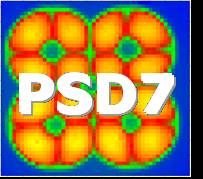Speaker
Mr
Sebastien Bonzom
(IPN Orsay, France)
Description
Surgery is still considered the primary therapeutic procedure for
high grade gliomas and several recent clinical studies have shown
that gross total tumor resection is directly associated with longer
and better survival when compared to subtotal resection. Considering
this context and based on a first experience in radio-guided surgery
[1,2], we are currently developing an intraoperative positron imaging
probe specifically designed to help neurosurgeons to locate residual
radiolabeled brain tumor (with 18F-FDG or FET) after the bulk has
been excised. Our detector was conceived to be compact and
electrically safe in order to be easily used inside the operative
wound jointly to other surgical tools.
We chose to build our imaging probe around plastic scintillating
multiclad fibers which optimize the detection of positrons emitted
by tumor while significantly reducing annihilation gamma rays
background noise. Scintillating fibers are disposed on two concentric
rings and are thermally fused to a 2 m length optical fiber bundle to
export the signal outside of the operative wound until a multi-
channel PMT. To eliminate the background noise, each detection
pixel is composed of 2 scintillating fibers: 1 on the internal ring
and 1 on the external ring which is beta shielded wich a thin inox
layer. The + distribution is obtained in real time by subtracting
the signal from these 2 fibers for each detection pixel.
Monte Carlo simulations using MCNP were realized on a voxelised
anthropomorphic brain phantom with different radiotracer activities
to optimize the detector geometry in a realistic clinical
environment. A first prototype of the probe composed of 8 detection
pixels is currently under development. Its experimental beta and
gamma sensitivities were measured using 204Tl and 22Na point sources.
Simulations show that optimal performances are obtained with 2 mm
diameter and 0.5 mm length scintillating fibers giving a gamma ray
rejection efficiency of 99.9%. These results were confirmed by
experimental measurements. With a homogeneous tracer distribution in
the tumor margins and a detector placed in contact with the tissues,
the probe sensitivity is 11 cps/nCi/mm3 for each detection pixel.
The theoretical minimum radiotracer detectable concentration is 1.8
nCi/mm3 for 18F-FET and an acquisition time of 5 s. This minimum
value has to be compared to the 2.9 nCi/mm3 average concentration of
18F-FET in the bulk of the tumor and is expected to be sufficient to
help surgeons to detect residual lesions in the resection margins of
the tumor.
In addition to these promising performances, we are performing
experimental measures on radioactive phantom to validate the
operating parameters of the probe in a clinical context.
Primary author
Mr
Sebastien Bonzom
(IPN Orsay, France)
